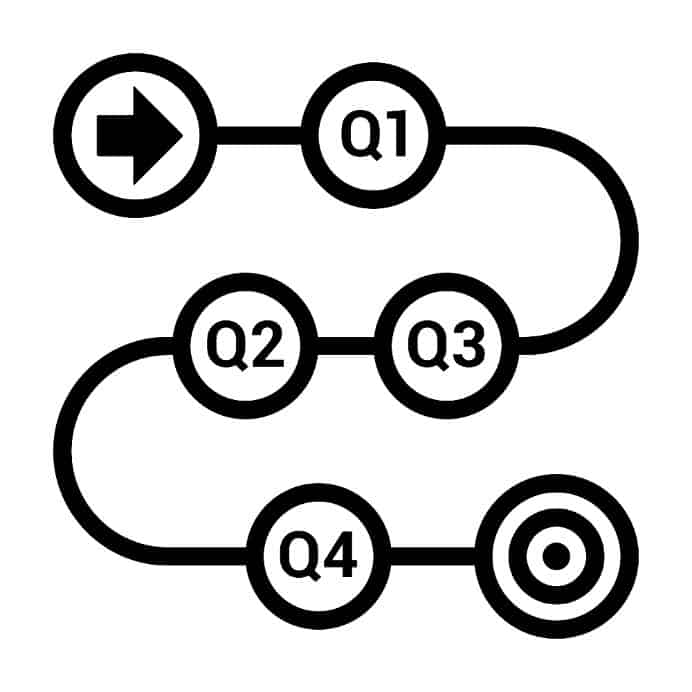With modern technologies rapidly changing and evolving, companies are under constant pressure to innovate quickly and deliver new products to the market faster. This often results in less than optimal product releases.
Having an innovative idea is not a guarantee of a quality product that will satisfy user needs as the development process will commonly face numerous roadblocks and, as a consequence, be held up by delayed decisions.
A good idea is just a starting point that serves to figure out the main properties of the product and the way it will fit the market. The implementation is where things get tricky and the ways to mess up multiply.
During the long time that it takes to finish development, countless factors will appear and influence the process, transforming the original idea. Because of this, it’s so important to keep everybody involved in development in sync and moving in the same direction.
This is where the product roadmap steps in as it allows everyone to understand what the product is, where it is currently, and where it’s heading next.
A product roadmap also serves as a communication tool helping product managers keep all key stakeholders engaged and well-informed and an authority that determines key aspects of a project, such as responsibilities, documentation requirements, milestones, deadlines, and success metrics.
Table of Contents
What is a Product Roadmap?
A product roadmap is an artefact that communicates a high-level visual overview of the direction of the product and puts the product’s strategic plans into action. Basically, it explains the why and the what behind the project the team is building.
The roadmap is based on the strategic direction of the product and helps the product team focus its efforts on what matters the most. So, it ties the production process to the broader strategy of the company and creates a general order of what is being built.
Besides describing the overall direction, the product roadmap should also fulfil several other important goals. It should provide guidance for executing the product strategy. In addition, the role of the product roadmap is to align all the internal stakeholders and facilitate and foster discussion on different directions and scenario planning.
If it manages to clearly articulate the product vision direction, the product roadmap makes it easier to secure the buy-in from the higher-ups in the company or potential investors. Finally, it should help the organisation communicate with the external stakeholders, especially customers.
A properly created product strategy
To do this, it should contain all the important aspects of the production process, including features, timelines, resources, and anything else off importance for the product development. With all this in place, a product roadmap can provide the basis for defining forward-looking objectives and approximate timelines for the product in development.
Plus, it serves as a platform for various stakeholders and product team members to weigh in on the product’s progress and defined goals. They’re able to do this because the product roadmap provides all internal and external stakeholders (senior management, sales team, marketing department, investors) with valuable insight into the current state of the product.
What Should a Product Roadmap Include?
Planning the product roadmap is not easy. Not every item in the process of product development deserves a spot on the roadmap. So, it’s important to properly prioritise and focus on the components that can be addressed in the set period of time, determine the priority-based goals, and define the metrics that will measure the success.
The context in which the product roadmap will vary from project to project and different types of audiences will require different approaches to roadmap planning. Each product map is unique and its structure and appearance will depend on the particular industry, the type of product that’s being developed, the size and structure of the team, and the specific needs of the company that’s releasing the product. Still, almost every roadmap will contain several key components.
Product Features
The product roadmap should describe the features of the product or, more precisely, the functions it will perform and the problems it’s supposed to solve. The team working on the product development will analyse the user feedback and decide which product features should be implemented next. Features can be further sorted into product themes or initiatives.
Product Goals
Each product roadmap should also feature clearly specified product goals, or time-bound and measurable objectives, along with well-defined success metrics. Their role in the product roadmap is to outline the crucial accomplishments that are required for a product to cross the gap between idea and reality.
Product goals should correspond to specific product features and indicate when and in what way should each feature be implemented. Some road maps will have multiple goals for the process of completing a single feature. For each goal, the road map should define measurable specifics and rough timelines.
Initiatives
Product features that must be implemented to accomplish goals are united on product roadmaps into broader themes or initiatives. Initiatives are on a higher level in the strategic hierarchy and indicate the work that needs to be completed as the development process moves towards the set objective.
Strategic initiatives can be overlaid on the product roadmap to show how particular features and releases are tied in with the overall strategy.
Product Releases
Every product feature is rolled out to the customers in a planned product release and every launch is represented on a timeline within the product roadmap. Often, multiple features or functionalities that bring value to customers are simultaneously launched as a part of the same release. When this is the case, a particular finished feature may be held up until other related features are completed, so they can be released at the same time.
Grouping multiple features in the same release is often a great way to improve user experience and their satisfaction with the products. For example, it’s much more convenient to have grouped software updates all released simultaneously than to download and install each of them separately at different times.
Another benefit of adding pre-planned product releases to the product roadmap is that it provides more time for the marketing team to design materials that will accompany the release. When done properly, even a simple product release can serve as a powerful sales tool.
Product Timeline
Product roadmaps will commonly include dates or time periods specifying when the new product or developed features of existing ones will be finished and released. Typically, the roadmap will not feature an exact date but only an approximation. The timescale can differ depending on the type of the product and the level of detail. It can be expressed in days, weeks, months, quarters, or even years.
The timeline of deliverables is also useful as it ties the product features, goals, and releases together. Each milestone on the product roadmap features not only the dates or time periods but also specifies which teams or individuals are responsible for a particular process and identifies stakeholders that could be affected by the certain product feature or goal completion.
Metrics
The product roadmap can include product metrics for each of the product releases. Product metrics are quantifiable data points that helps keep track on whether the product has met the goals for the product release and helps to gauge the success of the product release.
What are Different Types of Product Roadmaps?
Product roadmaps can be built in many different ways and feature different types of information and components. Each of these different roadmap types is designed to serve a specific purpose, so it can match the needs of stakeholders, product teams, and customers.
The first thing to do before creating a product map is to determine the potential audience it will serve. This will allow the map design to be specifically tailored to a particular group.
Depending on whether the potential audience is within or outside the organisation, product roadmaps can be internal or external. Internal roadmaps are used to communicate information needed by the specific departments within the company and are commonly intended for executives, the production team, or the sales department.
External product roadmaps are usually shared with the public and meant for customers or prospects. The most common examples of these roadmap types are explained below.
Internal Product Roadmap for Executives
The internal product roadmap for the executives should reflect the fact that they are mainly interested in a more strategic look at the data. So, the focus of the roadmap should be on strategic concepts of higher level, such as vision, strategic goals, driving growth, penetrating new markets, or customer satisfaction.
Securing the buy-in for the product vision from this group is extremely important for the whole development process, as it will provide necessary support and enthusiasm throughout the product’s life cycle.
Another type of product roadmap, similar to the one for the executives, may be created for the board members and investors. It will feature many similar components, but the overall focus should be on how the planned development will contribute to increasing the value of the product and the company.
A roadmap for board members and investors should emphasise how the new products or the updates to the existing ones will move the metrics most important to this audience.
Internal Product Roadmap for Engineers
When building a product roadmap for engineers, the most important elements will be the technical details, such as features, releases, deadlines, and technical aspects of implementation. Compared to the roadmap for the executive, this type is commonly shorter in duration, but more granular in scope. It should feature lower-level details based on the actual product, themes, and features.
While the engineers and other development and technical staff will not require particular emphasis on the vision, strategy, and potential for increasing revenue, the road map intended for them should still include the most important milestones and requirements set in front of other departments.
Internal Product Roadmap for Sales
The main concern for the sales teams is how the product can increase their sales. That means that the focus of the roadmap built for them will focus on the combination of product features and benefits those features can bring to the customers.
So, this product roadmap will mainly concentrate on the product value. The sales teams need to have a clear understanding of the value the product can bring, so they can communicate those benefits to potential customers and prospects. Grouping similar features or times into teams will make the job of sales reps a lot easier.
It’s important to note that some caution is advised when sharing internal roadmaps with the sales department. In some cases, sales reps may intentionally or unintentionally share the details of the internal roadmap with prospective customers in an effort to generate interest, keep the leads warm, or close the deal.
So, it’s often recommended to sometimes leave certain components, such as release dates, from the roadmap intended for Sales.
External Product Roadmap for Customers and Prospects
The sole focus of product roadmaps intended for customers and prospects should be on how the product will benefit them. This type of roadmap is commonly designed in the form of a presentation and omits any specific details about internal development processes.
As they’re designed for the audience outside the company, these roadmaps should be visually clear, easy to understand, and attractive. While they will go into detail on product benefits, external-facing roadmaps should not contain any precise information on deadlines and release dates, but only approximate timeframes.
Product Roadmap Template
Roman Pichler who has written several books on product management 

Author: Roman Pichler
Source: www.romanpichler.com
Licence: Creative Commons Attribution-ShareAlike 4.0 Unported (CC BY-SA 4.0), https://creativecommons.org/licenses/by-sa/4.0/

